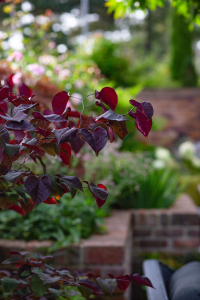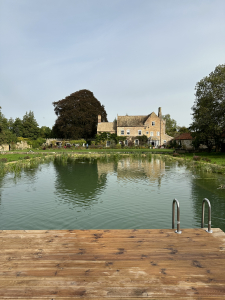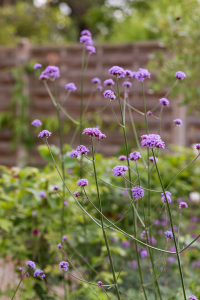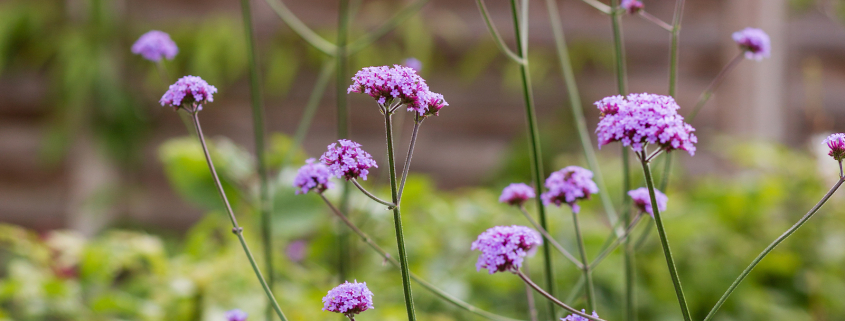Top 10 Tips to Enhance your Wildlife Garden this Autumn
Autumn in your garden means embracing simplicity and finding joy in nature. It’s the season of cosy jumpers, hot drinks, and the satisfying crunch of leaves underfoot. Your wildlife garden can become a haven of simple pleasures – watching birds flock to feeders, observing squirrels busily gathering nuts, and enjoying the earthy scent of damp soil.
Creating a wildlife garden in the autumn will not only add vibrant hues to your outdoor space but also contribute significantly to the ecosystem. By adopting sustainable practices and embracing the natural cycle of the season, you can transform your garden into a haven for various creatures, enhancing biodiversity and fostering a harmonious environment. View our recent project in Sandbanks, where we transformed a garden into a sustainable haven.

How to craft the perfect wildlife garden.
In this guide, we’ll explore essential steps to make your garden more inviting for wildlife, emphasising the principles of a sustainable and eco-friendly wildlife garden. To find more about Noscoe Garden Design’s wildlife garden services, click here.
There are specific steps you can take to make your garden even more inviting for wildlife and increase biodiversity:
- Leave seed heads and plant stems: Resist the urge to tidy. Instead of cutting back all the plants, leave seed heads standing. They provide valuable food sources and shelter for birds and insects during the colder months.
- Provide water sources: Place shallow dishes or bird baths in your garden to provide water for birds and other wildlife. Make sure to keep them clean and filled regularly.
- Create a compost pile: Autumn is a great time to start a compost pile with fallen leaves and garden waste. This not only reduces waste but also attracts insects and other decomposers, which in turn provide food for birds and other wildlife.
- Install bird feeders: Set up bird feeders filled with seeds and nuts. This will attract a variety of bird species to your garden, providing entertainment and food for them.
- Plant native trees and shrubs: Choose native trees and shrubs that provide food and shelter for wildlife. Species such as Prunus (cherry), Malus (crab apple), and Crataegus (hawthorn) are great options for attracting birds and insects.
- Create habitat piles: Stack logs, branches, and leaves in a corner of your wildlife garden to create a habitat pile. This provides valuable shelter for insects, small mammals, and amphibians.
- Plant late-blooming flowers: Include later flowering plants in your garden to provide nectar for bees, butterflies, and other pollinators. Examples include Aster, Hylotelephium (sedums), Verbena and Salvia ‘Amistad’.
- Avoid chemical pesticides: Instead of using chemical pesticides, opt for natural pest control methods such as companion planting, beneficial insects, and handpicking pests. This helps maintain a healthy ecosystem in your garden.
- Provide nesting boxes: Install bird boxes, bat boxes, and insect hotels to provide nesting sites for different species. Make sure they are placed in suitable locations and maintained properly.
- Maintain a diverse garden structure: Keep a mix of different plant heights and structures in your garden, including trees, shrubs, and groundcover. This provides varied habitats for wildlife.
Incorporating these tips into your gardening routine transforms your space into a thriving wildlife garden. By nurturing a sustainable garden, you not only provide a safe habitat for birds, insects, and other wildlife but also contribute to the overall health of the environment. Read more about sustainable gardening from the Royal Horticultural Society here.

Eco-Friendly Garden Practices
Embracing eco-friendly practices not only enhances the beauty of your garden but also plays a vital role in preserving our planet’s biodiversity.
Simple eco-friendly practices can make a significant difference. Consider composting your garden waste, turning it into nutrient-rich soil that reduces the need for chemical fertilisers. Opt for natural pest control methods, avoiding harmful pesticides, and encouraging beneficial insects to thrive. Collect rainwater to water your plants, conserving this precious resource. Planting native species not only attracts local wildlife but also requires less water and maintenance, reducing your ecological footprint. Learn more about our approach to gardening.
By adopting these eco-friendly habits, your garden becomes a testament to the harmony between humans and nature, creating a greener, more sustainable tomorrow for all.
So, go ahead, create your wildlife haven this autumn, and revel in the joy of observing nature flourish in your very own eco garden.

Click here to see more images on the website. Contact us now 07834 233 343, we can assist you with your dream garden, jenny@noscoegardendesign.com




Leave a Reply
Want to join the discussion?Feel free to contribute!